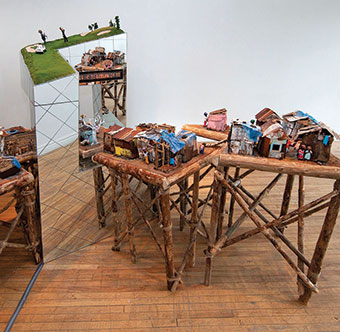Next story: Paintings by Candace Masters at Arts Sphere Gallery
Works by Heather Layton and Karine Giboulo at Buffalo Arts Studio
by Jack Foran

Grace and Gratitude
Global matters are on the minds of both artists in the current Buffalo Arts Studio show. Serious issues that the artists treat seriously but in both cases with a sense of humor.
Heather Layton’s works focus on Mexican ex-voto artworks, which are small-scale artistic commemorations of miraculous events in the lives of individuals. They consist of folk art paintings on tin or copper or wood depicting the miraculous event and a written description of the event circumstances, also naming the saint or deity credited with the miracle, who is also depicted in the painting. Layton’s display includes actual Mexican ex-votos and some she has made herself. Her own examples betray a more secular outlook than in the Mexican cases, but with no intent to be irreverential toward the religious mind set of the Mexican artists.
The written legend on one of the Mexican pieces reads, in translation: “Carmelo Ortiz, the banana man, when he was carrying a banana plant, a banana spider bit him in the neck and he prayed to Chalina’s saint, and since nothing happened to him he presents this little retablo to give his many thanks. Jalapa 1939.” In the picture we see Carmelo carrying a load of bananas, just as he seems to notice a huge black spider on his upper arm, but too late. Chalina’s saint, an image of Jesus Christ on the cross said to be venerated in the Village of Chalina, is depicted above in the near background.
One by Layton shows St. Brigid of Ireland, said to be the patron saint of poultry farmers, tending her flock of healthy-looking obviously free-range chickens, and reads: “I present this retablo to urge chicken farmers to stop raising chickens unethically, because artificially enhanced breasts, while attractive to some humans, are not sexy within the poultry population, and the steroids are detrimental to human health.”
Another authentic Mexican ex-voto says in the legend that “Mrs. Joaquina M. tried and tried to get pregnant without success, she swam in the waters of Tehuacán, praying to Saint Ramonsitio, and since she recently gave birth to her child, she presents this little retablo to give him many thanks. Puebla 1928.” The picture shows Joaquina swimming in the Tehuacán, naked, and the saint on the other shore, seeming to enjoy the sight. For that matter, she seems to be happy to see him as well. Maybe this explains something.
Other Layton works are retablo-size pieces of metal that are blank except for some apparent weathering, rust. The purpose of these pieces is to raise the issue of demand by the overheated current global art market for the folk art works. Layton tells the story of a priest being dragged out of his church by brigands and beaten while other members of their band pillaged the church for ex-votos that they would then sell on the black market. In response to the demand for these works, many copies are being made that are pawned off as authentic originals. One way to check for antiquity and likely authenticity of a piece is to look for weathering indications on the back of the metal.


The other half of the current exhibit is an elaborate sculptural installation by Karine Giboulo, consisting of multiple small clay figurines and shack dwellings of various media but prominently tin and wood, representing a mainly third-world village in Haiti along with several first-world scenarios for the Haitian one-percent and foreigners, including a golf course and a luxury resort where a few lucky regular Haitians get to be employed, serving tall cold drinks to the resort patrons basking around the swimming pool. The resort patrons are not actually human, but a kind of bloated porcine/ursine mix. And just to keep everything safe and orderly, the resort is well-guarded by what look like UN troops, with spiffy uniforms and blue helmets and formidable automatic weaponry.
Whereas the regular Haitians in the village for the most part don’t have jobs at all, at least of the sort first-world denizens would call jobs. They spend some time foraging in trash dumps for any kind of still usable material, such as the pieces of wood and tin and plastic they build their shack dwellings from, some of which items they may sell from their doorsteps. Some have a few vegetables or cheap manufactured goods for sale in the same way.
So what’s so funny in this case? The figurines and shack dwellings and other constructions, in a kind of Red Grooms ruckus style. Comic book quasi-realism. Though not the political message, which is hyper-realist.
The art installation village is said to imitate an actual village in Haiti, ironically named—and this is also the name of the art installation—Village Démocratie.
The Karine Giboulo and Heather Layton displays continue through August 4.
blog comments powered by Disqus|
Issue Navigation> Issue Index > v11n26 (Week of Thursday, June 28) > Art Scene > Works by Heather Layton and Karine Giboulo at Buffalo Arts Studio This Week's Issue • Artvoice Daily • Artvoice TV • Events Calendar • Classifieds |









 Current Issue
Current Issue